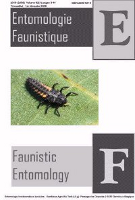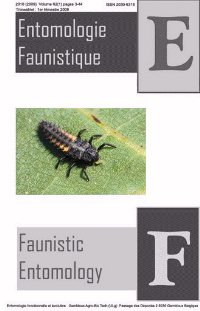- Accueil
- Volume 76 (2023)
- A new record of Sternocera chrysis (Fabricius 1775), the jewel beetle from Rajasthan's semi-arid region and its cultural significance as a traditional ornament
Visualisation(s): 3272 (2 ULiège)
Téléchargement(s): 36 (0 ULiège)
A new record of Sternocera chrysis (Fabricius 1775), the jewel beetle from Rajasthan's semi-arid region and its cultural significance as a traditional ornament

Document(s) associé(s)
Version PDF originaleAbstract
Sternocera chrysis (Fabricius, 1775), also known as the jewel beetle, was recorded for the first time in the Central Aravalli foothills of semi-arid Rajasthan in India. Previously, the species was discovered in the arid region of Rajasthan and in Southern India based on data available in published research papers and on the Global Biodiversity Information Facility, a citizen science platform. This article also discusses the traditional use of beetle heads as ornaments by local people and nomadic.
Table des matières
Reçu le 18 octobre 2022, accepté le 24 avril 2023, mis en ligne le 5 mai 2023
Cet article est distribué suivant les terms et les conditions de la licence CC-BY (http://creativecommons.org/licenses/by/4.0/deed.fr)
INTRODUCTION
1Insects, particularly beetles (Order: Coleoptera), have been extensively studied around the world since they are the largest order among insects, with 3,50,000 species worldwide (New, 2007) and constitute a significant component of the world's biodiversity. Over 1.5 million live insects and approximately 12,000 fossil insect species have been identified and described worldwide (Uniyal, 2001). The Indian subcontinent is home to over 15,088 beetle species (Kazmi & Ramamurthy, 2004). The coleopterans' adaptation to a wide range of eating preferences, combined with their largely hidden nature, has resulted in the invasion of many specialized habitats including such fungus and rotting vegetation, carcasses, and dung, and both larval and adult stages reside and feed in the same spot allows coleopterans to use these with maybe more efficiency than flies (Feroz et al. 2015). Beetles are detritus feeders, some eat flesh, dung, fungi, plants, pollen, flower, and fruit, others are predatory invertebrates, and some are parasites. Beetle species can be classified as both harmful and beneficial in agriculture based on their diets, with some species assisting to reduce the population of severe pests of agricultural products while other species target plants and grains as a pest. Beetles are prey for a variety of invertebrates and vertebrates such as insects, fish, reptiles, birds, and mammals. Studies on beetle reactions to habitat fragmentation in many regions of the world have yielded key ecological insights with far-reaching implications for practical conservation (Trumbo and Bloch, 2000). Evans and Bellamy (1996) coined the term "Beetlephilia" to describe many people's fascination with these insects, and in one of the few general essays to do so, emphasized the importance of conserving beetles as important components of the biosphere, with numerous keystone species and sustainers of numerous terrestrial ecosystem services.
Overview of Sternocera chrysis (Fabricius, 1775)
2Buprestidae insects vary in size and shape; in general, they are wood-boring beetles with dazzling metallic colors and oval bodies. The general characteristics include 11 segmented antennae with body lengths ranging from 1.5 to 100 mm (Booth et al., 1990). Sternocera is a genus in the Julodinae subfamily. They are enormous, strong beetles that are dark brown in color, with an iridescent green or bronze pitted thorax (Curran, 1946). Jewel beetles are wood boring beetles that are mainly xylophagous and found in semi-arid and wet tropical environments and because of their vibrant colors, they are one of the most immediately recognized families. They are tiny to large beetles with an elongated body that tapers towards the abdomen and a short head that fits tightly within the larger thorax (Bolu and Ozgen, 2011). Jewel beetles are one on the largely consumed edible insect in various parts of world (DeFoliart 1997) in both larval and adult forms.

Figure 1: Sternocera chrysis feeding on leaves of Cassia fistula
Distribution
3It has been found in India, Sri Lanka, Bangladesh, Bhutan, Nepal, Burma, Thailand, Vietnam, Pakistan, Laos, and China. Earlier in India Sternocera chrysis was recorded from Tamil Nadu (Balu et al. 2001) and later on from Jodhpur (Bhatnagar et al. 2018) arid region of state Rajasthan. 53 observations from Haryana, Gujarat, Maharashtra, Goa, Chhattisgarh, Telangana, Andhra Pradesh, Karnataka and Kerala (GBIF, 2022) in India of Sternocera chrysis was considered for range mapping (Fig. 2) from citizen science platform iNaturalist & Global Biodiversity Information Facility.

Figure 2: Distribution of Sternocera chrysis in India based on various sources.
Use as Traditional Ornament
4In the purpose of gaining some indigenous information for Sternocera chrysis, we came across the use of Sternocera chrysis heads in the creation of tassels, a traditional decoration used in rural Rajasthan. As displayed in Fig 3, the tassels are reported to be more than 100 years old and are passed down from generation to generation by women, with the 5th generation currently using them. According to information collected from local inhabitants, the vernacular name of Sternocera chrysis is "Bhingori". Each tassel is made up of approximately 150-200 heads of Sternocera chrysis indicates the rich abundance in population of Sternocera chrysis in that time.

Figure 3: Tassels made up from Sternocera chrysis heads around 100 years ago.
COMMENTS
5During our regular Lepidopteron Larvae Surveys in early October 2022, we discovered a Sternocera chrysis (Fig. 1) of the Buprestidae family feeding on a Cassia fistula Linn., plant in the central aravalli foothills of Ajmer (Rajasthan, India) where the climate is mostly semi-arid. Although this species has occurred in Arid and Forested regions of India, hitherto it was not recorded in semi arid regions of Rajasthan, India, making this record not only its first photographic record from this region, but also showing its use as a traditional ornament by the people of this region.
ACKNOWLEDGEMENTS
6We would like to thank Sanjay Saini and Kana Ram Kumawat from Department of Botany, Maharshi Dayanad Saraswati University Ajmer for identification of vegetation. We are also grateful to Manisha Rinwa for introducing us to tassels made from Sternocera chrysis heads.
Bibliographie
Balu A., Sasidharan K.R. & Rajarishi, R. 2001. A new record of root borer on Albizia lebbek in Tamil Nadu. Indian Forester. 127(8), 947-949.
Bhatnagar S., 2018. First Record of the Jewel Beetle Sternocera spp. (Coleoptera: Buprestidae) on Acacia Senegal in Jodhpur. The Bioscan, 13(2), 639-641.
Bolu H. & Özgen İ., 2011. On the Buprestidae (Coleoptera) Species of Almond Orchards in the Southeastern and Eastern Anatolia in Turkey, Munis Entomology and Zoology Journal, 6 (2), 970- 976.
Booth R.G., Cox M.L. & Madge R.B. 1990. IIE guides to insects of importance to man.3, Coleoptera. International Institute of Entomology & The Natural History Museum, London.
Curran C.H., 1946. Insects of the pacific world .American museum of natural history. The Macmillan Company— New York. 1-313.
DeFoliart G.R., 1997. An overview of the role of edible insects in preserving biodiversity. Ecology of Food and Nutrition, 36(2-4), 109-132.
Evans A.V. & Bellamy CL., 1996. An inordinate fondness for beetles. Henry Holt, New York
Fabricius J.C., 1775. Systema entomologiae : sistens insectorvm classes, ordines, genera, species, adiectis synonymis, locis, descriptionibvs, observationibvs. Officina Libraria Kortii, Flensbvrgi et Lipsiae. [xxxii], 832.
Feroz M., Tara J.S., Azam M. & Ramamurthy V., 2015. Staphylinidae, Scarabaeidae, Dermestidae and Curculionidae (Insecta: Coleoptera) first record, from Kargil (Ladakh), J&K-India. Munis Entomology & Zoology, 10(1), 172-182.
GBIF.org (12 October 2022) GBIF Occurrence Download https://doi.org/10.15468/dl.myyhxt
Kazmi S.I. & Ramamurthy V., 2004. Coleoptera (Insecta) fauna from the Indian Thar Desert, Rajasthan. Zoos’ print journal, 19(4). 1447-1448.
Trumbo S.T. & Bloch P.T., 2000. Habitat fragmentation and burying beetle abundance and success. Journal of Insect Conservation. 4(4). 245–252.
Uniyal V.P., 2001. Conserving biodiversity in the Indian Trans-Himalaya: New initiatives of field conservation in Ladakh. Annual technical report submitted to wildlife institute of India-Dehradun.
(13 Réf.)






